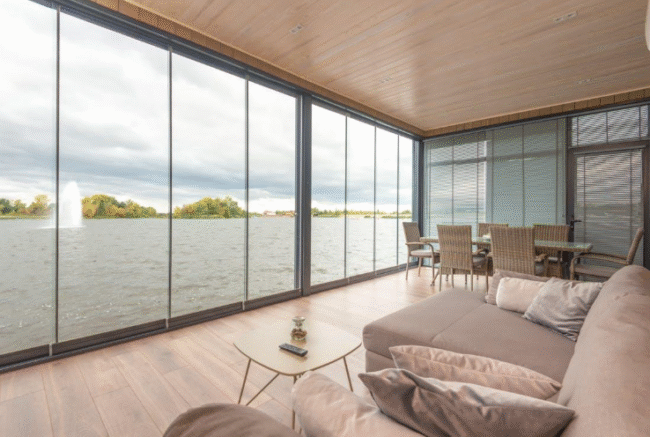
Jalousie windows are a unique type of window made up of overlapping, angled slats that can open and close like shutters. They allow for adjustable ventilation by controlling how much the slats are tilted open.
Choosing the perfect jalousie windows requires thinking through several factors like climate, aesthetics, function, and cost. This guide covers all the key considerations to help you make the best decision.
What Are Jalousie Windows?
A jalousie window consists of a series of angled glass, acrylic or wooden slats joined by hinges at the top that allow them all to be adjusted simultaneously with a crank device. The slats overlay each other when closed and can tilt open incrementally to control ventilation and airflow. Jalousie windows operate like mini louvered shutters fitted into a window frame.
Unlike many standard window styles that only open vertically or horizontally from one side, the overlapping slats enable custom configuration for both privacy and adjustable air circulation.
Jalousie windows have origins going back over a century. These windows combine characteristics of glass windows with adjustable shutters making them a specialty choice popular for certain climates.
The signature slats come in various materials like glass, acrylic plastics, and wood composites. Acrylic panels tend to be the most affordable option while real wood brings natural visual warmth.
For safety and durability against weather or intruders, glass is commonly tempered or reinforced to reduce shattering. Modern glass slats also often have extra UV or heat blocking coatings. Technologies continue advancing the energy efficiency, performance and resilience of jalousie window materials from trapping cool air in hot climates to insulating during cold winters.
Benefits of Jalousie Windows
There are good reasons jalousie windows have endured as a clever specialty window design. Their signature slats tilt open for an array of benefits not possible with many fixed window panels.
- Enhanced ventilation – Slats angle open to allow airflow while preventing rain getting inside. Great for circulating fresh air.
- Energy efficiency – Reflective materials and angled closure keeps heat and cold out.
- Natural light optimization – Slats can tilt open to let light in while minimizing direct sun.
- Aesthetic appeal – Unique visual appeal as an architectural feature.
Factors to Consider When Choosing Jalousie Windows
Homeowners looking to buy jalousie windows will want to assess what matters most for their particular home situation before deciding which window suits them best. Here are some important things you have to consider before you pick a window:
- Climate and weather – Frequent storms may mean selecting durable materials like shatter-resistant window glass.
- Home style – Choose slat materials and colors to match your home’s design.
- Size – Measure window openings carefully to get the perfect custom or standard-sized units.
- Security features – Options like reinforced frame construction and tamper-resistant hinge pins can boost safety.
Different Types of Jalousie Windows
When it comes to jalousie windows, you can find a few primary varieties when evaluating different products. These involve windows with different directional flow of the signature slatted shutters, intrinsic material used, custom production, and presence of any supplemental security reinforcements.
For ventilation direction, horizontal airflow jalousies suit regulating breezes drifting left or right better. Vertical jalousies instead channel airflow upward or downward more directly. Determine intended window exposure to guide which direction suits rooms best.
Glass slat windows promote durability while acrylic or plastic vanes cost less yet insulate efficiently. Real wood options add natural beauty but require rigorous weatherproofing protections. This can add up the cost over vinyl counterparts mimicking wood’s aesthetic at budget prices.
Custom building any jalousie window dimensions needed for exactly sized openings add expense but rewards through premium fit functionality. Multi-panel jalousies with subdivided grids also cost more while maximizing viewing perspectives through extra slat groupings.
Several jalousie security improvements provide better protections like tamper-resistant hinge pins foiling unauthorized access or tightly reinforced frames resisting forceful removal. Coastal regions may add impact-resistant glass protecting against airborne storm debris damages.
Installation Options
You can either tackle inserting jalousie windows as a DIY project or hire professional local contractors to complete necessary installations.
Realistic evaluations of your team’s handiness capabilities should guide decisions between DIY versus contractor installation. Jalousie window projects vary widely in complexity spanning easy jobs up to extensive custom structural projects requiring skilled pros.
Standard window jalousie insertions may work for ordinary DIYers comfortable measuring accurately then properly aligning, fastening and sealing units into existing frames or openings.
Handy homeowners must research proper jalousie handling, safe use of essential power tools, accurate shimming techniques and applying waterproof perimeter sealants when lacking carpentry experience.
Seeking professional guidance is smart when uncertain on any skills needed to correctly install jalousies yourself without risking expensive problems later requiring repairs. Patience is mandatory no matter what resources complete the project.
Maintenance and Care
Protecting jalousie window functionality requires regular cleaning and safety checks. But when well maintained, jalousies operate reliably for decades thanks to durable construction.
Follow manufacturer guidance on lubricating hinge pins allowing effortless slat adjustments. Acrylic or wood slats require occasional polish protecting surface sheen.
Use application methods avoiding liquid cleanser leaks damaging adjacent walls through open slats. Soft damp cloths alone often suffice removing surface dust and grime without harsh chemicals potentially scouring protective coatings.
Inspect weather seals around perimeter frames annually before seasonal weather shifts. Jalousies rely on tight perimeter seals preventing air and water infiltration. Reseal any cracked or peeling sections promptly to avoid leaks producing interior wall damages or mold concerns. Badly deteriorated seals require full replacement immediately before irreparable harm occurs.
Cost Considerations
The pricing of all the various jalousie window options can fluctuate based on distinguishing factors like:
- Materials – Real wood or premium UV/thermal glass slats cost more than economy options having vinyl, basic acrylic or standard glass types.
- Customization – Made-to-order measurements for perfectly sized insertion points or ornate grids increase budgets but add great looks through distinguished dimensions.
- Installation – Professional contractor project quotes encompass higher yet more thorough installation practices than DIY insertions alone excluding handywork tool purchases.
- Performance upgrades – Double pane insulation features, security reinforcements or decorative divided light grids boost aesthetics and functionality beyond basic models.
- Quantity – Bulk window orders for whole home replacements save per unit versus small singular needs. Spreading project phases lowers one-time investments.
Creating a budget checklist then requesting multiple contractor quotes helps homeowners compare apples-to-apples pricing on similar quality jalousie brands and installation methods.
Conclusion
Jalousie windows bring custom variable ventilation capabilities, daylighting controls, and signature aesthetic architectural accents to homes. But choosing ideal jalousies for your home first requires factoring local climate impacts, size constraints, and budget comfort levels.
Use this guide to inform discussions with jalousie window manufacturers when requesting quotes tailored around your home’s unique scenario. The perfect jalousie windows balancing charming looks with custom functionality await those putting in thoughtful research efforts beforehand.
